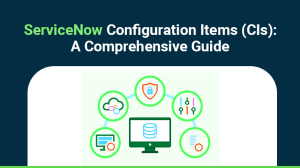ServiceNow has rapidly become one of the most powerful platforms for automating IT services, providing a wide range of solutions for enterprises of all sizes. Whether you’re completely new to ServiceNow or have experience with other IT Service Management (ITSM) platforms, this guide will help you get acquainted with the fundamentals of ServiceNow, enabling you to get started efficiently and set up the platform for your needs.
What is ServiceNow?
ServiceNow is a cloud-based platform designed to help companies manage digital workflows for enterprise operations. From IT service management (ITSM) to human resources, security operations, and customer service, ServiceNow centralizes and automates business processes to enhance efficiency, visibility, and reporting. It’s built on a single data model, which helps integrate various applications and services seamlessly.
Key Features of ServiceNow
Before diving into the platform, it’s important to understand some of the core features and functionalities that ServiceNow offers:
- Incident Management: Track and resolve incidents that disrupt services quickly, helping restore normal operations.
- Change Management: Plan, track, and control changes to systems and processes, ensuring minimal disruption.
- Service Catalog: Create a structured list of services that are available to end users, from hardware requests to system access.
- Workflow Automation: Automate repetitive tasks like approvals, notifications, and ticket assignment.
- Knowledge Management: Build and maintain a knowledge base for self-service support, reducing the load on IT staff.
- Configuration Management Database (CMDB): Manage your IT infrastructure and assets, creating a single source of truth for your environment.
- Reporting and Dashboards: Generate insightful reports and visual dashboards to track performance and KPIs.
- Integrations: Seamlessly integrate with third-party systems like Slack, Microsoft Teams, and external databases.
Understanding the ServiceNow Interface
The ServiceNow user interface may look overwhelming at first, but once you understand its layout, it becomes easy to navigate.
- Navigation Pane: Located on the left side, the navigation pane provides access to all applications and modules. Use the search bar to find specific modules quickly.
- Homepage: The homepage or “dashboard” is customizable and provides quick access to important metrics, tasks, and reports.
- Forms: These are used to create and update records in the platform. For example, incident forms, request forms, and change request forms are some of the common types.
- Lists: Lists display sets of records from a particular table (e.g., all open incidents). You can filter, group, and search within lists to narrow down relevant records.
- Global Search: This search bar allows you to search across all tables and records, making it easier to find specific information without navigating multiple menus.
Core Modules Every New User Should Know
1. Incident Management
One of the most widely used modules, Incident Management helps track and resolve IT issues efficiently. To create an incident:
- Navigate to Incident > Create New.
- Fill in key details such as caller name, short description, and category.
- Assign the incident to a specific user or team.
- Save and track the progress of the incident until resolution.
2. Change Management
Change Management helps ensure that changes to your IT infrastructure occur in a controlled and organized manner. To create a change request:
- Go to Change > Create New.
- Enter details about the change, including risk assessment and required approvals.
- Assign the change request and follow up on its progress through its lifecycle.
3. Service Catalog
The Service Catalog allows users to submit requests for services such as software installations, hardware purchases, and system access. You can:
- Navigate to Service Catalog.
- Browse available categories and select the service you need.
- Fill in any required details and submit the request for approval and fulfillment.
4. Knowledge Management
The Knowledge Management module is a powerful tool for building and maintaining a library of articles to support end-users and IT staff. To create a knowledge article:
- Navigate to Knowledge > Create New.
- Fill in the article template, including title, content, and categories.
- Publish the article so it’s available to other users in your organization.
5. Reporting and Dashboards
Reports and dashboards help track and visualize key metrics like incident resolution times, SLA performance, and system health. To create a report:
- Navigate to Reports > Create New.
- Select a report type (e.g., bar chart, pie chart).
- Choose the data source, such as a table or pre-built query.
- Customize the filters, grouping, and display options.
- Save and share your report or add it to a dashboard for easy access.
Best Practices for New Users
- Start with Training: ServiceNow offers a wide range of training resources, from beginner tutorials to advanced certification programs. Investing time in structured learning will help you get the most out of the platform.
- Use the Knowledge Base: The ServiceNow Knowledge Base is a valuable resource for troubleshooting and learning. If you’re stuck, search for solutions before escalating an issue.
- Leverage Templates: ServiceNow provides pre-built templates for various workflows, incidents, and change requests. Using these templates can help you save time and reduce errors.
- Set Up Notifications: Keep track of important updates by setting up email or mobile notifications for tasks, approvals, or incident assignments.
- Customize Dashboards: Tailor your dashboard to show the metrics and tasks most relevant to you. This helps ensure that important information is always visible at a glance.
- Ask for Help: If your organization has a ServiceNow admin or team, don’t hesitate to ask for help. They can assist with setting up workflows, creating reports, or troubleshooting issues.
ServiceNow Community and Resources
Becoming a part of the ServiceNow community is a great way to stay updated on the latest trends, releases, and best practices. You can also connect with other users to share knowledge and solve problems together.
- Now Learning: ServiceNow’s official learning platform, offering free and paid courses.
- NowTribe: NowTribe is fastest growing ServiceNow community
- ServiceNow Community: An online forum where users and experts discuss common issues, share tips, and collaborate on solutions.
- Now Support (HI): ServiceNow’s support portal, where you can log support cases, search the knowledge base, and access product documentation.
Conclusion
Getting started with ServiceNow might seem challenging at first, but with a solid understanding of the core features and best practices, you’ll be well on your way to leveraging the platform’s full potential. Whether you’re managing incidents, automating workflows, or creating reports, ServiceNow provides all the tools necessary to streamline and improve IT service management in your organization.
With time and practice, you’ll discover that ServiceNow is a flexible and scalable platform capable of transforming not only IT services but various other aspects of enterprise operations as well. Happy exploring!






